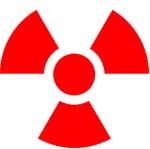(HOT) UPSC Current Affairs 2025 PDF
NEW! The Gist (NOV-2025) | E-BOOKS
(Info) About: Radiation Pollution
RADIATION POLLUTION
Radiation pollution is any form of
ionizing or nonionizing radiation that results from human activities.
 Ionizing
radiation:
Ionizing
radiation:
- Ionizing radiation is the short wavelength radiation or particulate radiation emitted by certain unstable isotopes during radioactive decay.
- There are about 70 radioactive isotopes, all of which emit some form of ionizing radiation as they decay from one isotope to another.
- A radioactive isotope typically decays through a series of other isotopes until it reaches a stable one.
- As indicated by its name, ionizing radiation can ionize the atoms or molecules with which it interacts. In other words, ionizing radiation can cause other atoms to release their electrons.
- These free electrons can damage many biochemicals, such as proteins, lipids, and nucleic acids (including DNA).
- In case of intense radiation, this damage can cause severe human health problems, including cancers, and even death.
Types of Ionizing radiation:
- Ionizing radiation can be either short-wavelength electromagnetic radiation or particulate radiation.
- Gamma radiation and X-radiation are short-wavelength electromagnetic radiation.
- Alpha particles, beta particles, neutrons, and protons are particulate radiation.
- Alpha particles, beta particles, and gamma rays are the most commonly encountered forms of radioactive pollution.
- Alpha particles are simply ionized helium nuclei, and consist of two protons and two neutrons. Beta particles are electrons, which have a negative charge. Gamma radiation is high-energy electromagnetic radiation.
Nonionizing radiation:
- It is relatively long-wavelength electromagnetic radiation, such as radio waves, microwaves, visible radiation, ultraviolet radiation, and very low-energy electromagnetic fields.
- Nonionizing radiation is generally considered less dangerous than ionizing radiation.
- However, some forms of nonionizing radiation, such as ultraviolet, can damage biological molecules and cause health problems.
- Scientists do not yet fully understand the longer-term health effects of some forms of nonionizing radiation, such as that from very low-level electromagnetic fields (e.g., high-voltage power lines), although the evidence to date suggests that the risks are extremely small.
Measurement of radioactivity:
- A Curie (Ci) represents the rate of radioactive decay. One Curie is 3.7 × 1010 radioactive disintegrations per second.
- A rad is a unit representing the absorbed dose of radioactivity. One rad is equal to an absorbed energy dose of 100 ergs per gram of radiated medium. One rad = 0.01 Grays.
- A rem is a unit that measures the effectiveness of radioactivity in causing biological damage. One rem is equal to one rad times a biological weighting factor. The weighting factor is 1.0 for gamma radiation and beta particles, and it is 20 for alpha particles.
- One rem = 1000 millirem = 0.01 Sieverts.
- The radioactive half-life is a measure of the persistence of radioactive material. The half-life is the time required for one-half of an initial quantity of atoms of a radioactive isotope to decay to a different isotope.
Radioactive Pollution - Biological Effects Of Radioactivity:
- The amount of injury caused by a radioactive isotope depends on its physical half-life, and on how quickly it is absorbed and then excreted by an organism.
- Most studies of the harmful effects of radiation have been performed on single-celled organisms. Obviously, the situation is more complex in humans and other multicellular organisms, because a single cell damaged by radiation may indirectly affect other cells in the individual.
- The most sensitive regions of the human body appear to be those which have many actively dividing cells, such as the skin, gonads, intestine, and tissues that grow blood cells (spleen, bone marrow, lymph organs).
- Radioactivity is toxic because it forms ions when it reacts with biological molecules. These ions can form free radicals, which damage proteins, membranes, and nucleic acids. Radioactivity can damage DNA (deoxyribonucleic acid) by destroying individual bases (particularly thymine), by breaking single strands, by breaking double strands, by cross-linking different DNA strands, and by cross-linking DNA and proteins. Damage to DNA can lead to cancers, birth defects, and even death.
Radioactive Pollution - Nuclear Weapons Testing:
- Nuclear weapons release enormous amounts of radioactive materials when they are exploded.
- Most of the radioactive pollution from nuclear weapons testing is from iodine-131, cesium-137, and strontium-90.
- Iodine-131 is the least dangerous of these isotopes, although it has a relatively half-life of about eight days. Iodine-131 accumulates in the thyroid gland, and large doses can cause thyroid cancer.
- Cesium-137 has a half-life of about 30 years. It is chemically similar to potassium, and is distributed throughout the human body. Based on the total amount of cesium already in the atmosphere, all humans will receive about 27 millirems of radiation from cesium-137 over their lifetime.
- Strontium-90 has a half-life of 38 years. It is chemically similar to calcium and is deposited in bones. Strontium-90 is expelled from the body very slowly, and the uptake of significant amounts increases the risks of developing bone cancer or leukemia.
Contributed By: Vijay Jha

